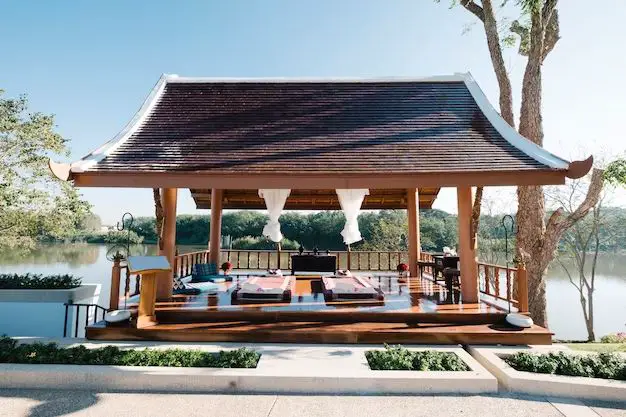When looking to build or buy a gazebo, one of the most important considerations is choosing a material that will stand the test of time. The longer a gazebo lasts, the less often you’ll have to repair or replace it, saving you money and hassle in the long run. In this article, we’ll examine which gazebo materials are the most durable and long-lasting.
Page Contents
Wood
Wood is a classic gazebo material that has been used for centuries. Western red cedar is one of the best wood species for gazebos because it has natural resistance to rot and insect damage. Redwood, cypress, and pressure-treated pine also make good choices. The advantage of wood is that it’s beautiful and natural looking. Wood gazebos can last 10-15 years or more when properly maintained.
The downside is that wood requires regular staining or painting to protect it from the elements. Unprotected wood will crack, warp, and rot over time. Wood is also susceptible to damage from termites and carpenter ants. Keeping wood gazebos well-sealed and painted is key to making them last.
Maintenance Tips for Wood Gazebos
- Inspect regularly for cracking, peeling paint, or insect damage
- Sand and repaint every 2-3 years
- Re-stain or seal natural wood annually
- Keep wood off the ground with stone or concrete footings
Vinyl
Vinyl is a popular modern alternative to wood gazebos. Vinyl is a plastic material that won’t crack, peel, rot, or be damaged by insects. It holds up very well to sun, rain, and snow. Vinyl gazebos are virtually maintenance free. They never need to be painted or stained. Vinyl can last up to 20 years or longer.
On the downside, vinyl can become brittle and fade over time. Lower quality vinyl may warp or become discolored after years in the sun. Vinyl gazebos are also susceptible to damage from high winds if not properly anchored.
Maintenance Tips for Vinyl Gazebos
- Scrub occasionally with vinyl cleaner
- Rinse away salt and debris to prevent corrosion
- Re-anchor with gazebo tie-downs if winds cause shifting
- Replace faded or warped vinyl panels
Aluminum
Aluminum is lightweight, durable, and naturally rustproof, making it an excellent gazebo frame material. Aluminum does not rot, peel, crack, or get damaged by insects. It stands up very well to sun, rain, and salt air. With proper maintenance, an aluminum frame gazebo can last 15-20 years.
The downside of aluminum is that it can bend or dent if impacted. Also, bare aluminum will oxidize to a chalky finish over time. Regular cleaning and painting are needed to keep aluminum gazebos looking pristine.
Maintenance Tips for Aluminum Gazebos
- Wash regularly with mild detergent
- Check for dents after storms
- Repaint oxidation areas every 2-3 years
- Reinforce with additional braces if structure bends
Wrought Iron
Wrought iron is another classic gazebo material prized for its elegance and durability. Cast iron and steel gazebo frames offer similar qualities. Wrought iron has a long lifespan of 15-25 years. It will never rot, crack, or become damaged by insects.
Wrought iron’s strength makes it very wind and impact resistant. Regular sealing and paint touch ups are needed to prevent rust damage, however. This material is also on the heavy side and more expensive than other options.
Maintenance Tips for Wrought Iron Gazebos
- Clean and seal with rust inhibiting paint annually
- Check for rust spots or peeling paint after storms
- Repair scratches or dents immediately
- Reinforce loose joints or supports as needed
Brick or Stone
For the ultimate lifetime gazebo, a brick or natural stone structure is your best bet. Brick and stone masonry can stand up to just about anything for 50 years or more. Brick and stone won’t rot, dent, bend, or become damaged by pests.
Properly constructed stone and brick have excellent resistance to wind, rain, sun, and impact. They’re also attractive materials that add value to any property. The downside is the very high initial cost for these permanent structures.
Maintenance Tips for Brick and Stone Gazebos
- Use a gentle cleaner and water to wash occasionally
- Check mortar for cracks and repoint as needed
- Clear debris from rain gutters if present
- Have any major repairs done by a stonemason
Comparison of Gazebo Materials
| Material | Durability | Maintenance | Cost |
|---|---|---|---|
| Wood | 10-15 years | High | Low |
| Vinyl | 15-20 years | Low | Medium |
| Aluminum | 15-20 years | Medium | Medium |
| Wrought Iron | 15-25 years | Medium | High |
| Brick/Stone | 50+ years | Low | Very High |
Conclusion
When it comes to lifetime cost, maintenance requirements, and durability, brick and natural stone are the longest lasting gazebo materials. A sturdy and properly constructed brick or stone gazebo can realistically last over 50 years. Brick and stone gazebos don’t require much for upkeep beyond occasional cleaning and minor repairs.
Wood and aluminum gazebos are moderately durable options lasting about 15-20 years with proper care. Vinyl is the lowest maintenance option, while wood requires the most upkeep. Wrought iron offers elegance, strength, and a long lifespan of 15-25 years. Consider your budget, location, and lifetime expectations when choosing a gazebo material. An informed choice will reward you with years of enjoyment under your gazebo.
